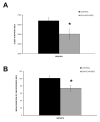Effects of adolescent ethanol exposure on sleep in adult rats
- PMID: 18922666
- PMCID: PMC2858580
- DOI: 10.1016/j.alcohol.2008.08.001
Effects of adolescent ethanol exposure on sleep in adult rats
Abstract
Although adolescent ethanol (EtOH) exposure has been associated with long-lasting changes in brain function, little is known as to whether EtOH exposure during adolescence alters sleep and cortical arousal. This study examined protracted alterations in sleep in adult rats exposed to EtOH during adolescence. Adolescent male Wistar rats were exposed to EtOH vapor for 12 h/day for 5 weeks. Cortical electroencephalograms were obtained during 4-h recording sessions after 5 weeks of withdrawal from EtOH. Adolescent EtOH exposure significantly reduced the mean duration of slow-wave sleep (SWS) episodes and the total amount of time spent in SWS in EtOH-exposed rats, compared to controls. Spectral analysis revealed that adolescent EtOH exposure significantly increased cortical peak frequencies during SWS in the 2-4, 4-6, and 6-8 Hz bands. Taken together, our findings suggest that chronic EtOH exposure in adolescent rats reduces measures of SWS, an effect also seen as part of normal aging. Although the cellular and molecular mechanisms mediating the consequences of EtOH exposure on the aging process are not known, the similarities between adolescent EtOH exposure and aging merits further investigation.
Figures
Similar articles
-
Electrophysiological effects of dizocilpine (MK-801) in adult rats exposed to ethanol during adolescence.Alcohol Clin Exp Res. 2008 Oct;32(10):1752-62. doi: 10.1111/j.1530-0277.2008.00760.x. Epub 2008 Jul 24. Alcohol Clin Exp Res. 2008. PMID: 18652596
-
Effect of Gabapentin on Sleep and Event-Related Oscillations (EROs) in Rats Exposed to Chronic Intermittent Ethanol Vapor and Protracted Withdrawal.Alcohol Clin Exp Res. 2018 Mar;42(3):624-633. doi: 10.1111/acer.13588. Epub 2018 Jan 31. Alcohol Clin Exp Res. 2018. PMID: 29286538 Free PMC article.
-
Altered EEG responses to ethanol in adult rats exposed to ethanol during adolescence.Alcohol Clin Exp Res. 2002 Feb;26(2):246-54. Alcohol Clin Exp Res. 2002. PMID: 11964565
-
Effects of chronic ethanol exposure on sleep in rats.Alcohol. 2000 Feb;20(2):173-9. doi: 10.1016/s0741-8329(99)00077-4. Alcohol. 2000. PMID: 10719796
-
Adolescent ethanol exposure: does it produce long-lasting electrophysiological effects?Alcohol. 2010 Feb;44(1):27-37. doi: 10.1016/j.alcohol.2009.09.033. Alcohol. 2010. PMID: 20113872 Free PMC article. Review.
Cited by
-
Prenatal alcohol exposure and sleep-wake behaviors: exploratory and naturalistic observations in the clinical setting and in an animal model.Sleep Med. 2019 Feb;54:101-112. doi: 10.1016/j.sleep.2018.10.006. Epub 2018 Oct 25. Sleep Med. 2019. PMID: 30530254 Free PMC article.
-
The role of sex in the persistent effects of adolescent alcohol exposure on behavior and neurobiology in rodents.Int Rev Neurobiol. 2021;160:305-340. doi: 10.1016/bs.irn.2021.07.007. Epub 2021 Aug 11. Int Rev Neurobiol. 2021. PMID: 34696877 Free PMC article. Review.
-
Effects of an Orexin-2 Receptor Antagonist on Sleep and Event-Related Oscillations in Female Rats Exposed to Chronic Intermittent Ethanol During Adolescence.Alcohol Clin Exp Res. 2020 Jul;44(7):1378-1388. doi: 10.1111/acer.14361. Epub 2020 Jun 12. Alcohol Clin Exp Res. 2020. PMID: 32424852 Free PMC article.
-
Prolonged chronic ethanol exposure alters neuropeptide Y and corticotropin-releasing factor levels in the brain of adult Wistar rats.Pharmacol Biochem Behav. 2011 Jul;99(1):104-11. doi: 10.1016/j.pbb.2011.04.005. Epub 2011 Apr 17. Pharmacol Biochem Behav. 2011. PMID: 21527271 Free PMC article.
-
Homeostatic NREM sleep and salience network function in adult mice exposed to ethanol during development.Front Neurosci. 2023 Nov 14;17:1267542. doi: 10.3389/fnins.2023.1267542. eCollection 2023. Front Neurosci. 2023. PMID: 38033546 Free PMC article.
References
-
- Angelakis E, Lubar JF, Stathopoulou S, Kounios J. Peak alpha frequency: an electroencephalographic measure of cognitive preparedness. Clin Neurophysiol. 2004;115:887–897. - PubMed
-
- Angelakis E, Stathopoulou S, Frymiare JL, Green DL, Lubar JF, Kounios J. EEG neurofeedback: a brief overview and an example of peak alpha frequency training for cognitive enhancement in the elderly. Clin Neuropsychol. 2007;21:110–129. - PubMed
-
- Arendt T, Allen Y, Marchbanks RM, Schugens MM, Sinden J, Lantos PL, Gray JA. Cholinergic system and memory in the rat: effects of chronic ethanol, embryonic basal forebrain brain transplants and excitotoxic lesions of cholinergic basal forebrain projection system. Neuroscience. 1989;33:435–462. - PubMed
-
- Barron S, White A, Swartzwelder HS, Bell RL, Rodd ZA, Slawecki CJ, Ehlers CL, Levin ED, Rezvani AH, Spear LP. Adolescent vulnerabilities to chronic alcohol or nicotine exposure: findings from rodent models. Alcohol Clin Exp Res. 2005;29:1720–1725. - PubMed
-
- Beracochea D, Micheau J, Jaffard R. Memory deficits following chronic alcohol consumption in mice: relationships with hippocampal and cortical cholinergic activities. Pharmacol Biochem Behav. 1992;42:749–753. - PubMed
Publication types
MeSH terms
Substances
Grants and funding
LinkOut - more resources
Full Text Sources


